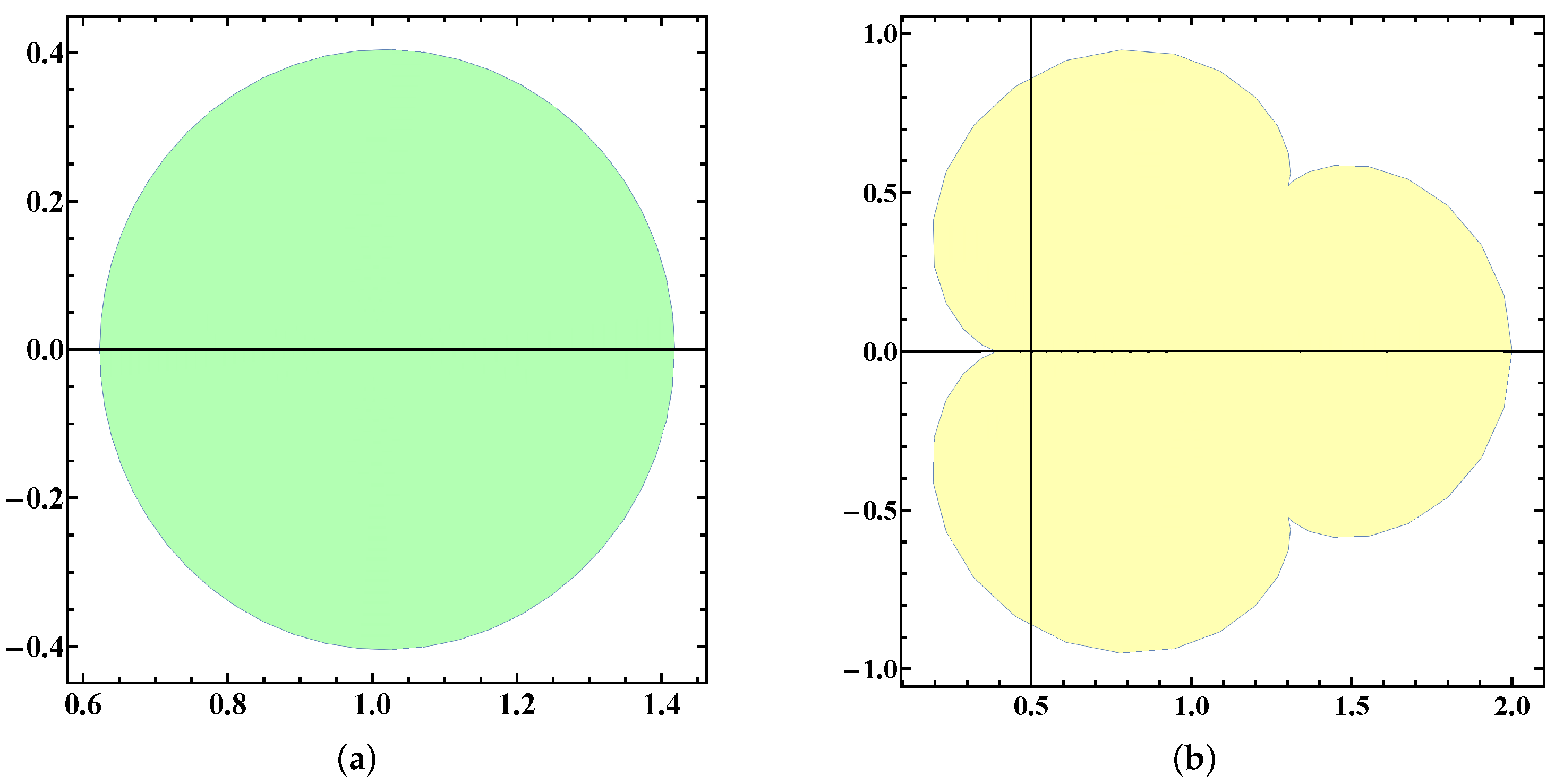Applications of Mittag–Leffler Functions on a Subclass of Meromorphic Functions Influenced by the Definition of a Non-Newtonian Derivative
Abstract
:1. Introduction and Definition
2. Main Results
3. Analytic Functions with Respect to Symmetric Points
4. Conclusions
Author Contributions
Funding
Data Availability Statement
Acknowledgments
Conflicts of Interest
References
- Srivastava, H.M.; Bansal, M.; Harjule, P. A study of fractional integral operators involving a certain generalized multi-index Mittag–Leffler function. Math. Methods Appl. Sci. 2018, 41, 6108–6121. [Google Scholar] [CrossRef]
- Aouf, M.K.; El-Emam, F.Z. Fekete–Szegö problems for certain classes of meromorphic functions involving q-Al-Oboudi differential operator. J. Math. 2022, 2022, 4731417. [Google Scholar] [CrossRef]
- Horrigue, S.; Madian, S.M. Some inclusion relationships of meromorphic functions associated to new generalization of Mittag–Leffler function. Filomat 2020, 34, 1545–1556. [Google Scholar] [CrossRef]
- Umadevi, E.; Karthikeyan, K.R. A subclass of close-to-convex function involving Srivastava-Tomovski operator. In Recent Developments in Algebra and Analysis. ICRDM 2022. Trends in Mathematics; Leung, H.H., Sivaraj, R., Kamalov, F., Eds.; Birkhäuser: Cham, Switzerland, 2024. [Google Scholar] [CrossRef]
- Srivastava, H.M.; Tomovski, Ž. Fractional calculus with an integral operator containing a generalized Mittag–Leffler function in the kernel. Appl. Math. Comput. 2009, 211, 198–210. [Google Scholar] [CrossRef]
- Tomovski, Ž.; Pogány, T.K.; Srivastava, H.M. Laplace type integral expressions for a certain three-parameter family of generalized Mittag–Leffler functions with applications involving complete monotonicity. J. Frankl. Inst. 2014, 351, 5437–5454. [Google Scholar] [CrossRef]
- Tomovski, Ž.; Hilfer, R.; Srivastava, H.M. Fractional and operational calculus with generalized fractional derivative operators and Mittag–Leffler type functions. Integral Transform. Spec. Funct. 2010, 21, 797–814. [Google Scholar] [CrossRef]
- Aouf, M.K.; Shamandy, A.; Mostafa, A.O.; Madian, S.M. Properties of some families of meromorphic p-valent functions involving certain differential operator. Acta Univ. Apulensis 2009, 20, 7–16. [Google Scholar]
- El-Ashwah, R.M.; Aouf, M.K. Differential subordination and superordination on p-valent meromorphic function defined by extended multiplier transformations. Europ. J. Pure Appl. Math. 2010, 3, 1070–1085. [Google Scholar]
- Karthikeyan, K.R.; Murugusundaramoorthy, G. Properties of a Class of Analytic Functions Influenced by Multiplicative Calculus. Fractal Fract. 2024, 8, 131. [Google Scholar] [CrossRef]
- Bashirov, A.E.; Kurpinar, E.M.; Özyapıcı, A. Multiplicative calculus and its applications. J. Math. Anal. Appl. 2008, 337, 36–48. [Google Scholar] [CrossRef]
- Bashirov, A.E.; Mısırlı, E.; Tandoğdu, Y.; Özyapıcı, A. On modeling with multiplicative differential equations. Appl. Math. J. Chin. Univ. 2011, 26, 425–438. [Google Scholar] [CrossRef]
- Ma, W.C.; Minda, D. A unified treatment of some special classes of univalent functions. In Proceedings of the Conference on Complex Analysis, Tianjin, China, 19–23 June 1992; International Press: Boston, MA, USA, 1992; pp. 157–169. [Google Scholar]
- Karthikeyan, K.R.; Murugusundaramoorthy, G.; Bulboacă, T. Properties of λ-pseudo-starlike functions of complex order defined by subordination. Axioms 2021, 10, 86. [Google Scholar] [CrossRef]
- Gandhi, S.; Gupta, P.; Nagpal, S.; Ravichandran, V. Starlike functions associated with an Epicycloid. Hacet. J. Math. Stat. 2022, 51, 1637–1660. [Google Scholar] [CrossRef]
- Ahmad, A.; Gong, J.; Al-Shbeil, I.; Rasheed, A.; Ali, A.; Hussain, S. Analytic Functions Related to a Balloon-Shaped Domain. Fractal Fract. 2023, 7, 865. [Google Scholar] [CrossRef]
- Sakaguchi, K. On a certain univalent mapping. J. Math. Soc. Japan 1959, 11, 72–75. [Google Scholar] [CrossRef]


Disclaimer/Publisher’s Note: The statements, opinions and data contained in all publications are solely those of the individual author(s) and contributor(s) and not of MDPI and/or the editor(s). MDPI and/or the editor(s) disclaim responsibility for any injury to people or property resulting from any ideas, methods, instructions or products referred to in the content. |
© 2024 by the authors. Licensee MDPI, Basel, Switzerland. This article is an open access article distributed under the terms and conditions of the Creative Commons Attribution (CC BY) license (https://creativecommons.org/licenses/by/4.0/).
Share and Cite
Breaz, D.; Karthikeyan, K.R.; Murugusundaramoorthy, G. Applications of Mittag–Leffler Functions on a Subclass of Meromorphic Functions Influenced by the Definition of a Non-Newtonian Derivative. Fractal Fract. 2024, 8, 509. https://doi.org/10.3390/fractalfract8090509
Breaz D, Karthikeyan KR, Murugusundaramoorthy G. Applications of Mittag–Leffler Functions on a Subclass of Meromorphic Functions Influenced by the Definition of a Non-Newtonian Derivative. Fractal and Fractional. 2024; 8(9):509. https://doi.org/10.3390/fractalfract8090509
Chicago/Turabian StyleBreaz, Daniel, Kadhavoor R. Karthikeyan, and Gangadharan Murugusundaramoorthy. 2024. "Applications of Mittag–Leffler Functions on a Subclass of Meromorphic Functions Influenced by the Definition of a Non-Newtonian Derivative" Fractal and Fractional 8, no. 9: 509. https://doi.org/10.3390/fractalfract8090509







